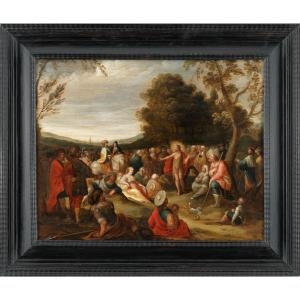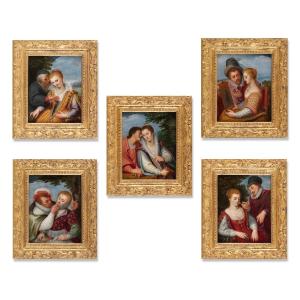In this series, flirtatious couples engage in sensory experimentation: an old man brushes the neckline of a young woman, another holds out a fragrant flower to his partner, a third brings a stick of sugar to his companion's lips, the next proposes to his lady to observe her reflection in the mirror that he hands her and finally, the last whisper in the ear of his sweetheart. Strawberries, doublets, brocaded dresses, jewelry sets, toques and felt hats make up a veritable catalog of fashion in vogue at the end of the 16th century, stimulating the spectator's view through a rich palette and making him imagine the sensations of textures. Thus, these characters experience both their senses and the joys of courtly love. This is a break with the classic iconography of the representation of the five senses which, inspired by the writings of Pliny the Elder, symbolized each of them by an animal (the cat embodying sight, the bird touch, etc).
Hendrick Goltzius was the first to break with this semiology in a set of drawings engraved by Jan Saenderam around 1595. In this first series, animals were relegated to the background in favor of couples similar to ours. However, our work goes further by abandoning any animal representation, the attention being focused on the expression of feelings and pleasures through subtle exchanges of glances and hand games. In this case, the delicate design of the figures is closer to the original drawing by Goltzius than to the more Mannerist engravings of his pupil Saenderam. The rosy complexions, the voluptuous bodies, without excessive muscularity, and the powerful colors, are all clues that reveal a proto-baroque manner, inherited from the Venetian Renaissance, and which was adopted by Goltzius in the 1600s as evidenced by his Danae and the Golden Rain of 1603 (Los Angeles County Museum). This stylistic consideration combined with this iconographic milestone increased by a certain originality suggests that this would be an autograph work by Hendrick Goltzius.
Our five panels are enhanced by delicate Louis XIV style frames.
Dimensions: 39 x 33.5 with frames
Hendrick Goltzius (Mülbracht 1558 – Haarlem, 1 Jan. 1617) was born into a family of painters but began his career as an artist by becoming an apprentice to the engraver Dirck Volkertsz. Coornhert in 1574. He followed his master to Haarlem in 1577 where he worked until the end of his life, with the exception of a stay in Italy in 1591 which had a considerable impact on his art. His friend, Karel van Mander, thus relates the influence that had on him the "soft paintings of Raphael" but especially the "naturalism of the skins of Correggio", the "important contrasts of shadow of Titian" and the "superb materials and fabrics of Veronese”. These discoveries prompted him to abandon the late Mannerism of his early career in favor of a more classicizing approach based on the late Renaissance and to take up oil painting, a medium he did not practice before that. In 1582, Goltzius opened his own printing press, which enabled him to distribute his engravings and to enrich himself considerably. Having had precarious health all his life, he died in 1617, the city of Haarlem having celebrated his funeral by ringing the bells for half an hour.
Bibliography:
- DACOSTA KAUFMANN, Thomas, The Prague School: Painting at the Court of Rudolf II, Flammarion, 1984.
- NICHOLS, Lawrence W., The Paintings of Hendrick Goltzius, 1558-1617, A Monograph and Catalog Raisonné, Davaco Publishers , 2013,
- VELDMAN, Ilja M., Images for the eye and soul: function and meaning in Netherlandish prints (1450-1650), Primavera Pers, Leiden, 2006


























 Le Magazine de PROANTIC
Le Magazine de PROANTIC TRÉSORS Magazine
TRÉSORS Magazine Rivista Artiquariato
Rivista Artiquariato
